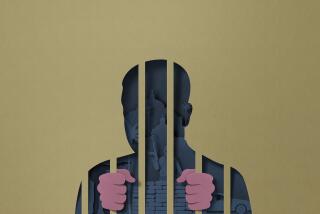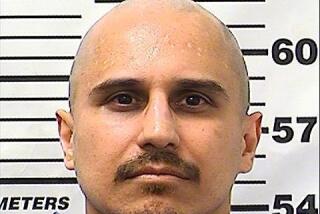Mob Turns Milquetoast as Tough Guys Vanish
- Share via
NEW YORK — Where have you gone, Tony Salerno?
Where is your tough-guy snarl, your cigar screwed tightly into a jaw jutting above several chins?
Where are your buddies, those wise guys right out of central casting--”Tony Ducks” hunched at the defense table, or “The Snake” jawing with a judge in a bench conference?
Just 15 years ago, “Fat Tony” Salerno and the heads of New York’s four other Mafia families were at the center of the “Commission Trial”--the biggest mob prosecution ever, a riveting legal tarantella danced in a Manhattan courtroom.
The trial, featuring Carmine “The Snake” Persico acting as his own attorney, was interrupted by the mob-ordered murder of co-defendant “Big Paul” Castellano. Rudy Giuliani, a hotshot federal prosecutor, pursued the surviving mobsters with a gusto unseen since Elliot Ness targeted Al Capone in the early 1930s.
Through the decades, the mob trial has endured as an American fixture, a riveting drama of Good versus Evil played out for an always appreciative audience.
It was pure Hollywood: tension, confrontation, spectacle. Capone’s trial became fodder for the hit movie “The Untouchables”; mob-skimming of Las Vegas gambling money, which led to the 1985 convictions of three Midwest Mafia bosses, inspired the acclaimed film “Casino.”
But here in the new millennium, it’s all disappearing--much like the mob families whose misdeeds once filled dockets around the country.
“You probably won’t see many big trials coming up,” acknowledges mob expert Howard Abadinsky, a former consultant to the president’s commission on organized crime. “Quite frankly, who in his right mind in the 21st century gets involved with the Mafia?”
The images of the mob on trial were striking: Frank Costello’s shaky hands on national television during the Kefauver Commission hearings; a smirking John Gotti cracking wise in a $2,000 designer suit; a withered Vincent “The Chin” Gigante wheeled into the courtroom by his brother--a Bronx priest in full clerical garb.
The results were striking too: eight convictions in the Commission trial, sweeping guilty pleas that disabled crime families in Cleveland, Kansas City, New England and New York, the exposure of widespread skimming from Las Vegas casinos.
And now?
There’s Gotti’s goofy son-in-law, Carmine Agnello, scowling above a nondescript sweatsuit as he faces trial for threatening a rival junkyard dealer--a competitor set up as a police sting.
Or Louis Manocchio, the reputed boss of the New England mob who pleaded guilty to misdemeanor charges last year for giving stolen property--a dishwasher and refrigerator--to his 90-year-old mother.
Or “Fat Dom” Borghese, the 21st century version of a mob informant. He can’t fill the shoes (or fit in the pants) of the great mob witnesses of the past: Joe Valachi, Jimmy “The Weasel” Fratianno, “Crazy Phil” Leonetti, Sammy “The Bull” Gravano.
Borghese was one of the snitches set to testify against John Gotti Jr., whose alleged crimes included gambling and fraud--hardly the stuff of his father’s brutal reign atop the Gambino family. (John Sr. had Castellano murdered during the Commission trial.)
Ex-prosecutor Andrew Maloney, who helped put the elder Gotti behind bars in 1992, is reluctant to proclaim the death of the big mob trial. But he acknowledges that most of the big names are behind bars, along with many of the smaller names: “There’s no more room at the inn.”
Blame it on the Racketeer Influenced and Corrupt Organizations Act, the 1970 federal racketeering statute that helped jail scores of mobsters. Before RICO, mob trials were an exciting rarity. In the first years of RICO, there were scads of big trials in New York, New England, Philadelphia, Kansas City. Now there are few mob trials and even fewer good ones.
“Organized crime is used to RICO now,” Abadinsky says. “They’re a bit more cautious about doing business.”
The highest-profile organized crime trial in the pipeline involves the 38-year-old Agnello--a mob wannabe who made his bones at the altar, not in the street. Agnello goes on trial in U.S. District Court next year.
Agnello is the estranged husband of Victoria Gotti, the daughter of jailed-for-life John. Once a legitimate businessman who earned millions of dollars, Agnello inexplicably opted to join the illicit family business, authorities say.
Agnello lacks a nickname. He never sipped cappuccino while holding court in a Little Italy social club; instead, he operated out of a Queens junkyard--more Fred Sanford than Carlo Gambino.
His father-in-law made the cover of Time magazine in a portrait by Andy Warhol. Agnello is generally a grainy black-and-white shot on page 10 of the New York Post.
This is the biggest mob fish left?
Even the promise of his striking, blond wife attending the trial disappeared when the couple recently split up.
“He’s an imbecile,” said somebody who would know--Gotti himself. The Dapper Don disparaged Agnello at a jailhouse meeting with his daughter, a meeting taped by authorities.
“Look, you want a prediction? By June her husband’s gonna be indicted,” Gotti said, gesturing at Victoria. In January 2000, Gotti’s prediction came true when Agnello was charged with using arson and extortion to try to co-opt a rival Queens scrap yard.
That operation was actually a police sting. And its target wasn’t even Agnello; he simply rose to the bait set for somebody else.
For his efforts, Agnello remains jailed in lieu of $18-million bond.
The last great mob trial was the 1997 prosecution of Genovese family boss Vincent “Chin” Gigante, who received a 12-year sentence for murder conspiracy, racketeering and extortion. He was accused of plotting to kill the elder Gotti, among others.
Gigante’s first brush with notoriety came at an infamous mob trial 39 years earlier. The “Chin” was accused of botching a hit on mob boss Frank Costello, who survived a graze wound to his head.
“This one’s for you, Frank,” said Gigante, staring at his victim before missing his target.
Gigante was arrested for attempted murder; Costello was the star prosecution witness. In classic Mafia style, the mob boss--even after donning his glasses on the witness stand--insisted he could not identify his assailant.
“I would have dropped dead if he answered,” said Gigante’s attorney, Maurice Edelbaum, after Costello’s silence produced the Chin’s acquittal.
Years later, authorities viewed Gigante as a criminal genius; the Chin avoided prosecution for years by feigning mental illness while running the powerful Genovese family, they charged.
At his trial, Gigante’s brother-- the Rev. Louis Gigante, a Bronx priest--wheeled him about the courthouse. The elderly mob boss sat mutely during the trial, never once breaking character.
His family argued that Gigante’s ailment was legitimate, although officials said the act was growing old. Authorities had arrived years earlier to arrest Gigante in a separate case, only to find him naked in a running shower beneath an umbrella.
Agnello lacks the panache to pull off such a stunt, although his father-in-law apparently thinks Agnello has grounds for a defense arguing mental defect.
“So what’s the story with Carmine?” he asked Victoria at their jailhouse meeting.
“What do you mean, what’s the story with him?” she replied.
“Is he feeling good? Is he not feeling good?” Gotti shot back. “Is his medication increased? Decreased? . . . Does he get in the back seat of the car and think someone has stolen the steering wheel?”
At the trials of both the elder Gotti and Gigante, the appearance of star informant Sammy Gravano turned two Brooklyn courtrooms into the judicial equivalent of court-side seats at Madison Square Garden.
Made men battled G-men for seats; a queue formed in the hallway, as if waiting for the doors to open at a Springsteen concert. Gravano, looking almost professorial with glasses and a surgically altered face, was a star, baby.
The whole thing predictably became a made-for-TV movie called “Witness to the Mob.” Gravano’s star turn turned ugly recently when he was arrested in Arizona on drug charges.
The potential for one last, great trial is still out there--as is the potential defendant, James “Whitey” Bulger, the Boston mobster who disappeared in 1995 as authorities were closing in on him.
The FBI hasn’t given up the hunt for the longtime head of Boston’s Winter Hill Gang. Last year, Bulger was placed on its list of 10 most wanted fugitives--and the trial of Whitey would be a blockbuster.
The Irishman once did time on Alcatraz. He’s been indicted--twice--since going on the lam. He and his sidekick, Stephen “The Rifleman” Flemmi, allegedly corrupted an FBI agent while working as government informers.
All of which raises an obvious question: Where have you gone, Whitey Bulger?
More to Read
Sign up for Essential California
The most important California stories and recommendations in your inbox every morning.
You may occasionally receive promotional content from the Los Angeles Times.










